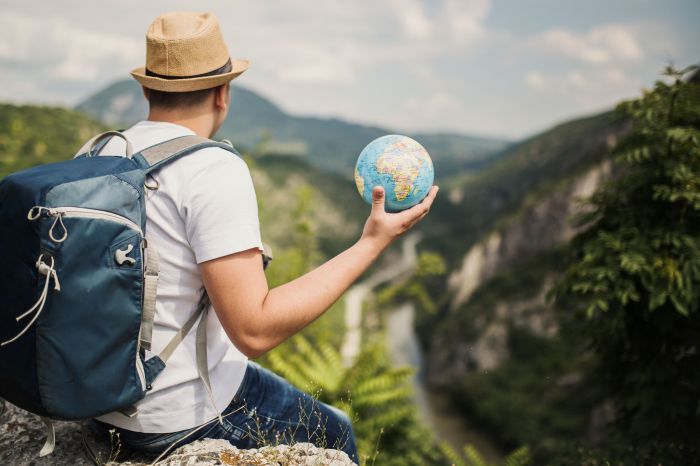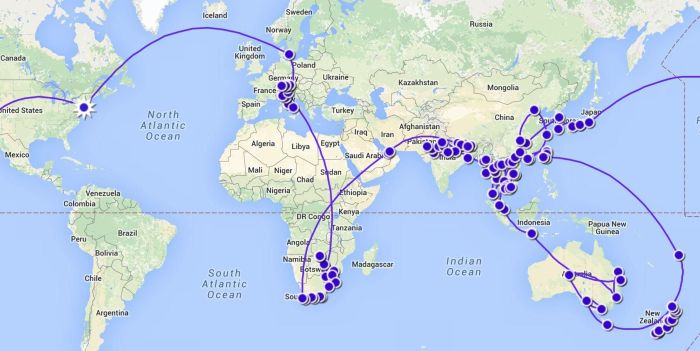Best Way To Travel Around The World? It’s a question echoing in the minds of countless adventurers. This isn’t just about ticking off destinations; it’s about crafting an unforgettable experience. From meticulously planned itineraries to embracing spontaneous detours, the journey itself becomes the reward. This guide unravels the secrets to navigating the globe efficiently, affordably, and most importantly, memorably, covering everything from budgeting and transportation to cultural sensitivity and safety.
We’ll dissect the complexities of global travel, breaking down the best transportation options, accommodation choices, and packing strategies to suit every budget and travel style. Learn how to optimize your spending, secure the best deals, and avoid common pitfalls. Whether you’re a seasoned backpacker or a first-time globetrotter, this comprehensive guide will empower you to plan and execute the world trip of your dreams.
Budgeting for a Round-the-World Trip

Planning a round-the-world trip requires meticulous budgeting. Ignoring this crucial step can lead to financial strain and ultimately, a less enjoyable experience. Understanding your spending habits and setting realistic expectations are key to making your dream trip a reality without breaking the bank. This section will provide a framework for creating a comprehensive budget, exploring various travel styles and offering money-saving strategies.
Sample Budget Breakdown for a Three-Month Backpacking Trip
A three-month backpacking trip offers a fantastic balance of exploration and affordability. This sample budget assumes a moderate level of comfort, prioritizing experiences over luxury. Adjust figures based on your individual preferences and chosen destinations.
| Category | Estimated Cost (USD) | Notes |
|---|---|---|
| Flights (Round-Trip) | $1500 – $2500 | Prices vary drastically depending on origin, destination, and booking time. Consider budget airlines and flight comparison websites. |
| Accommodation (Hostels, Guesthouses) | $1500 – $2500 | Average $25-$50 per night. Consider booking in advance, especially during peak season. |
| Activities & Entrance Fees | $1000 – $2000 | Allocate funds for sightseeing, tours, and cultural experiences. Prioritize free activities like hiking and exploring local markets. |
| Food | $1500 – $2500 | Budget for street food, local markets, and occasional restaurant meals. Cooking your own meals whenever possible can significantly reduce costs. |
| Transportation (Local Transport, Buses, Trains) | $500 – $1000 | Utilize cost-effective transportation options like buses and trains whenever possible. |
| Miscellaneous (Visas, Travel Insurance, Souvenirs) | $500 – $1000 | Factor in unexpected expenses and allocate funds for essential travel insurance. |
| Total Estimated Cost | $6500 – $11500 | This is a broad estimate; actual costs can vary significantly. |
Comparison of Different Travel Styles and Associated Costs
Travel styles significantly impact overall trip expenses. Luxury travel involves higher-end accommodations, fine dining, and private tours, resulting in substantially higher costs. Budget travel, on the other hand, emphasizes affordability, often involving hostels, budget airlines, and street food. Mid-range travel offers a balance between comfort and cost-effectiveness.
| Travel Style | Accommodation | Food | Activities | Daily Estimated Cost (USD) |
|---|---|---|---|---|
| Luxury | 5-star hotels, resorts | Fine dining, upscale restaurants | Private tours, exclusive experiences | $500+ |
| Mid-Range | Comfortable hotels, boutique guesthouses | Mix of local eateries and restaurants | Combination of free and paid activities | $100-$200 |
| Budget | Hostels, guesthouses, Airbnb | Street food, local markets, self-catering | Free activities, budget tours | $30-$75 |
Strategies for Saving Money While Traveling
Several strategies can significantly reduce travel expenses. Leveraging rewards programs for flights and accommodations can offer substantial savings. Utilizing free Wi-Fi, walking or using public transport, and eating at local markets instead of restaurants all contribute to cost reduction.
Cost of Living in Popular Travel Destinations
This table compares the cost of living across five popular travel destinations. Note that these are average estimates and can fluctuate depending on the season and specific location within the city.
| City | Accommodation (per night) | Food (per day) | Activities (per day) |
|---|---|---|---|
| Bangkok, Thailand | $10-$50 | $15-$30 | $20-$50 |
| Chiang Mai, Thailand | $8-$40 | $10-$25 | $15-$40 |
| Medellin, Colombia | $15-$60 | $15-$35 | $25-$60 |
| Lisbon, Portugal | $30-$100 | $25-$50 | $30-$70 |
| Budapest, Hungary | $25-$80 | $20-$40 | $25-$60 |
Packing Essentials for a Global Journey

Embarking on a three-month round-the-world adventure requires meticulous planning, and packing efficiently is paramount. Overpacking leads to unnecessary weight, fatigue, and potential logistical headaches. A strategic approach to packing, prioritizing versatile items and minimizing unnecessary baggage, will significantly enhance your travel experience. This section Artikels a packing list, strategies for light packing, and tips for protecting your belongings.
Clothing Selection for a Three-Month Trip
Choosing versatile clothing is key to minimizing the amount you pack. Opt for neutral-colored, quick-drying fabrics that can be mixed and matched. Consider the climates you’ll be visiting and pack accordingly. Layering is your friend; a base layer, mid-layer, and outer shell provide adaptability to fluctuating temperatures.
- 7-10 pairs of versatile underwear (consider merino wool for odor resistance)
- 3-4 pairs of socks (again, merino wool is excellent)
- 2 pairs of comfortable walking shoes
- 1 pair of sandals or flip-flops
- 2-3 pairs of versatile pants or skirts (convertible pants are ideal)
- 4-5 shirts or tops
- 1 light jacket or sweater
- 1 raincoat or waterproof jacket
- 1 warm layer (fleece or down jacket, depending on destinations)
- Swimsuit(s)
- Pajamas
- Hat
- Sunglasses
Toiletries and Essential Items
Travel-sized toiletries are essential for minimizing weight and complying with airline regulations. Invest in reusable containers to reduce waste and repackage items from larger bottles. Remember to check the regulations of any countries you’ll be visiting regarding specific items.
- Toothbrush, toothpaste, floss
- Shampoo, conditioner, soap (consider solid bars to reduce liquid volume)
- Deodorant
- Sunscreen
- Insect repellent
- First-aid kit (including pain relievers, antiseptic wipes, band-aids)
- Medications (prescription and over-the-counter, with copies of prescriptions)
- Small towel (microfiber towels are lightweight and quick-drying)
Essential Documents and Their Protection
Protecting your passport, visas, and other important documents is crucial. Consider scanning these documents and storing them electronically in a secure cloud-based service, as well as carrying physical copies separately from the originals. A money belt or hidden pouch can help secure valuables.
- Passport (with at least six months validity remaining)
- Visas (if required)
- Copies of travel documents (passport, visa, flight itineraries, travel insurance)
- Driver’s license (if applicable)
- Credit cards and debit cards
- Emergency contact information
- Travel insurance information
Protecting Your Belongings During Travel
Protecting your belongings requires a multi-faceted approach. Using a sturdy, lockable suitcase and utilizing TSA-approved locks is a good start. Consider packing cubes to compress clothing and keep items organized. Be mindful of your surroundings and avoid displaying expensive items ostentatiously.
Luggage Organization for Easy Access
Organize your luggage to maximize efficiency and minimize frustration. Pack frequently used items, such as medications, electronics, and toiletries, in easily accessible locations. Utilize packing cubes or compression bags to separate items by category and compress clothing. A well-organized bag makes navigating customs and accessing essentials much smoother. Consider a small daypack for carrying essentials while exploring.
Safety and Health Considerations: Best Way To Travel Around The World
Embarking on a round-the-world journey is an incredible experience, but prioritizing safety and health is paramount. Failing to do so can quickly transform an adventure into a nightmare. This section will equip you with the knowledge and strategies to navigate potential challenges and ensure a smooth, healthy trip. Remember, proactive planning is your best defense.
Staying Safe While Traveling
Protecting yourself from theft and scams requires vigilance and common sense. In high-traffic areas, be mindful of your belongings. Avoid displaying expensive jewelry or electronics. Use secure methods of carrying your money, such as money belts or hidden pockets. Be wary of unsolicited help or overly friendly strangers who might be trying to distract you.
Before you travel, research common scams in your destinations and learn how to identify them. For example, the “fake police officer” scam is prevalent in many tourist hotspots. This involves someone impersonating a police officer to gain access to your valuables. Learning to identify these scams will significantly reduce your risk. Additionally, always keep a copy of your passport and important documents separate from the originals.
Travel Insurance: A Crucial Investment
Travel insurance is not a luxury; it’s a necessity. A comprehensive plan can cover medical emergencies, lost luggage, trip cancellations, and even personal liability. Consider factors such as your itinerary, planned activities, and pre-existing medical conditions when selecting a plan. For instance, if you plan on engaging in adventurous activities like scuba diving or trekking, ensure your policy covers those activities.
Compare plans from different providers to find the best coverage at a reasonable price. Don’t underestimate the potential costs of medical treatment abroad; they can be exorbitant. A good travel insurance policy can provide peace of mind and financial protection in unexpected situations.
Health Considerations: Vaccinations and Precautions
Your health is your responsibility. Consult your doctor well in advance of your trip to discuss necessary vaccinations and recommended medications. Many countries require specific vaccinations, and others recommend them based on the prevalence of certain diseases. For example, yellow fever vaccination might be mandatory for entry into certain African countries. Your doctor can also advise you on necessary precautions against common illnesses such as malaria, typhoid, and dengue fever.
Pack a comprehensive first-aid kit including any prescription medications you require. Remember to stay hydrated, eat at reputable establishments, and practice good hygiene to minimize your risk of illness.
Safety and Health Checklist, Best Way To Travel Around The World
Proactive planning is key. Here’s a checklist to guide you:
- Before the Trip: Research your destinations, obtain necessary visas and vaccinations, make copies of important documents, inform your bank and phone provider of your travel plans, purchase comprehensive travel insurance, pack a well-stocked first-aid kit, and learn basic phrases in the local language.
- During the Trip: Be aware of your surroundings, avoid walking alone at night, use reputable transportation, keep valuables secure, be cautious of scams, stay hydrated, eat at clean establishments, and practice good hygiene.
- After the Trip: Review your travel insurance policy, follow up with your doctor regarding any necessary post-trip checkups, and share your travel experiences responsibly.
Ultimately, the best way to travel around the world is the way that best suits
-you*. This guide provides a framework, a toolkit if you will, to help you build your perfect adventure. Remember to prioritize your personal preferences, balance planning with spontaneity, and embrace the unexpected. The world is vast and wondrous, waiting to be explored. So, start planning, pack your bags, and get ready for the journey of a lifetime.
The world awaits!

